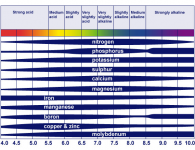FluxCherry
Active member
Off the top of my head. Light stress mostly, acting like light stress and low humidity. possibly Micro nutrient lacking. possibly ph issue.I am back in hydroton ebb flo and out of practice. See attached pics.
RO
2.5ml/g silica blast
Jacks321
.5ml/g mr fulvic
1.7ec
ph 5.5-6.2
RH 50-62%
73-82F
View attachment 18919340
View attachment 18919341
View attachment 18919343
View attachment 18919342 View attachment 18919344
I was thinking calcium deficiency, so I brought the RH down to lower 50%'s and have let the PH drift up to 6.2. New growth not showing tip burn and they've been at this ec for almost a week. I have one plant that is un affected, a cindy cake cross. These are mixed of Trinity, SFV and Sour D.




